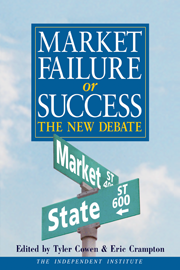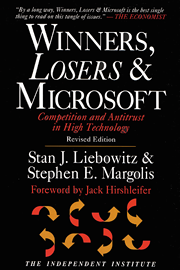Product definition is an important feature of antitrust, whether the industry is old technology or new. It is crucial in the Microsoft case. Is Microsoft’s operating system with its Internet browser one product with efficiently integrated features, or are there two products that are, as Joel Klein argues, “bolted” together? The government has alleged, and Judge Jackson has found, that there are two separate products, and that the “bolting” constitutes an illegal tie-in.
To find an illegal tie between two goods, one first must find two goods. To find that there are two goods, Judge Jackson draws on two U.S. Supreme Court cases and puts forward a rule that two products exist if consumers perceive two markets for two goods. Whatever the outcome of the Microsoft antitrust case, this rule is bad economics that would undermine antitrust practice and damage competition and innovation.
Twenty years ago, a thriving industry provided after-market rustproofing for automobiles. New-car buyers in the Northern U.S. and Canada took their cars to rustproofers like Ziebart, or had dealers arrange rustproofing before delivery. But starting in the mid-seventies, and accelerating dramatically in the early to mid-eighties, automobile manufacturers began to incorporate extensive rustproofing. They improved designs and made heavy use of galvanizing and other coatings. Integrating rustproofing into manufacturing and design worked much better than adding it on. Today consumers expect integrated rustproofing and long-term warrantees on rust resistance. The small aftermarket for rustproofing that remains is mostly confined to restored older cars and repaired newer ones. No doubt the after-market rustproofers that were crowded out by manufacturers’ improvements bewailed the loss of their market, but consumers are much better off.
What criteria tell us whether we have one good or two? Shirts come with buttons already “integrated,” that is, sewn on. But buttons can be purchased alone. Does this mean that Lands’ End is practicing a tie-in sale when it sells shirts with buttons? Cars are supplied with tires, but tires can be purchased separately, and some new-car buyers trade in their new tires immediately. Does this mean that equipping cars with tires could be an illegal tie-in sale?
Of course not. But why not? The temptation is to dismiss the whole thing with an appeal to common sense: Shirts with buttons and cars with tires are each single goods for which repair parts are available—don’t be ridiculous. But there is something to be learned from avoiding this temptation and asking why it would be ridiculous to call this a tie-in. Shirts have buttons and cars have tires because selling these goods that way yields the greatest net benefits to consumers. That is to say, by and large, the advantages of the integrated products are sufficiently large that the overwhelming share of consumers want them that way. The premium that consumers are willing to pay for a button-equipped shirt or a tire-equipped car is considerably more than the cost of including those features at the time of manufacture. And the costs of catering to the tastes of the few who are offended by the standard-equipment buttons or tires are large and the benefits are small.
So button-equipped shirts make common sense, but they make common sense because they also pass a cost-benefit test. And so we return to the problem of one good or two. From an economic perspective, we should regard two “features” as constituting a single integrated good if the benefits of having the integrated products exceed the costs. In most contexts, this cost-benefit calculation is left to consumers.
Judge Jackson does attempt to ground his finding that there are two separate products in consumer sovereignty, drawing on the Jefferson Parish and Eastman Kodak cases: “The significance of those cases, for this Court’s purposes, is to teach that resolution of product and market definitional problems must depend upon proof of commercial reality, as opposed to what might appear to be reasonable. In both cases the Supreme Court instructed that product and market definitions were to be ascertained by reference to evidence of consumers’ perception of the nature of the products and the markets for them, rather than to abstract or metaphysical assumption as to the configuration of the ‘product’ and the ‘market.’... In the instant case, the commercial reality is that consumers today perceive operating systems and browsers as separate ‘products,’ for which there is separate demand” (Findings of Law, p. 29).
There are two problems with this. First, consumers can perceive separate markets, even when the benefits of integration overwhelm the costs. Separate markets exist for shirts and buttons, cars and tires, cars and rustproofing, yet few people would object to these integrations. Interestingly, an additional consideration for the Jefferson Parish court was whether significant numbers of consumers, perceiving separate markets, were being forced to buy something that they didn’t wish to buy from the defendant. The question is, in effect, is whether many people lose very much by the attachment of buttons that they would rather not have purchased from the shirtmaker. Further, if few consumers would elect an un-integrated version, it is difficult to argue that requiring companies to offer such versions could affect the competitive landscape. Of course, banning shirt makers from selling buttons at all would induce entry of button-only sellers, but only because the low-cost means of satisfying consumers’ demands has been blocked.
Second, with changes in technology, both the cost-benefit comparison and consumer perceptions can change. So the “commercial reality” that “consumers today perceive” does not resolve much. In 1975 consumers undoubtedly perceived separate markets and products for cars and rustproofing. A contract that compelled consumers to buy added-on rustproofing only from authorized car dealers might well have flunked a cost-benefit test, while harming independents like Ziebart. But ten years later, few would have disputed the benefits of manufactured-in rust resistance. Where technology change offers new product integration, a rule that compels a look at consumer perceptions as though frozen in time will be harmful.
So what about the integration of the computer operating system and the browser? The much-debated issue of whether it is possible to remove the browser without damaging the operating system says nothing about whether integration might be advantageous. A pair of scissors will remove buttons without damaging a shirt. The real question, whether an operating system with a built in browser might offer advantages, has received far less attention. But the U.S. Court of Appeals for the D.C. Circuit was pretty clear on this, even with respect to earlier less-integrated products: “We think that an ‘integrated product’ is most reasonably understood as a product that combines functionalities (which may also be marketed separately and operated together) in a way that offers advantages unavailable if the functionalities are bought separately and combined by the purchaser. On the facts before us, Microsoft has clearly met the burden of ascribing facially plausible benefits to its integrated design as compared to an operating system combined with a stand-alone browser such as Netscape’s Navigator.”
Judge Jackson’s reading of Jefferson Parish and Eastman Kodak give us an approach to new-product development that will serve us poorly in the new century. Products and markets change. Products are integrated and are separated on the merits. Many high-technology markets are subject to network effects and other characteristics that will cause market leaders to have very high market shares. Those same market leaders, we should hope, will continue to innovate on many fronts, one of which will be product integration. As in the past, companies will offer their “solutions,” advancing on what have been regarded as individual products. Ratification of a rule that hinders such developments will give us less innovation, not more.









